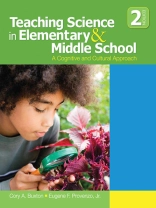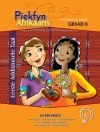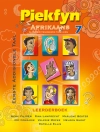A practical methods text that prepares teachers to engage their students in rich science learning experiences
Featuring an increased emphasis on the way today′s changing science and technology is shaping our culture, this Second Edition of Teaching Science in Elementary and Middle School provides pre- and in-service teachers with an introduction to basic science concepts and methods of science instruction, as well as practical strategies for the classroom. Throughout the book, the authors help readers learn to think like scientists and better understand the role of science in our day-to-day lives and in the history of Western culture. Part II features 100 key experiments that demonstrate the connection between content knowledge and effective inquiry-based pedagogy. The Second Edition is updated throughout and includes new coverage of applying multiple intelligences to the teaching and learning of science, creating safe spaces for scientific experimentation, using today′s rapidly changing online technologies, and more.
Valuable Instructor and Student resources:
- The password-protected Instructor Teaching Site includes video clips that illustrate selected experiments, Power Point® lecture slides, Electronic Test Bank, Teaching guides, and Web resources.
- The open-access Student Study Site includes tools to help students prepare for exams and succeed in the course: video clips that illustrate selected experiments, chapter summaries, flash cards, quizzes, helpful student guides links to state standards, licensure exams and PRAXIS resources, and Learning from SAGE Journal Articles.
विषयसूची
Preface
Part I. Creating the Context for Science Education
1. The Nature of Science
What Is Science?
Theory Into Practice 1.1: Nature of Science Cards
What Science Is Not
How Science Is Done
Theory Into Practice 1.2: Hidden Shapes
Patterns That Connect
Qualities of Scientific Inquiry
Combining the Qualities of Scientific Inquiry to Address Scientific Questions
Theory Into Practice 1.3: The Hypothesis Box
Paradigms and Paradigm Shifts in the Nature of Science
Summary
Student Study Site
Reflections on Science
Learning Science On-Line: Researching Scientist Biographies
Internet Connections: Nature of Science Resources
References
2. Science Education in Social Context
The Historical Role of Science Education in Our Society
Theory Into Practice 2.1: What Would Life Be Like Without Certain Inventions?
Science Education Within Broader Educational Reforms
Theory Into Practice 2.2: Education Reform and You
The Contemporary Role of Science Education in Our Society and the Current Wave of Science Education Reform
Theory Into Practice 2.3: D efinitions of Scientific Literacy
Broader Education Reforms and Science Education
Learning to Speak the Language of Science
Theory Into Practice 2.4: Metaphors in Science
Ethics in Science and the Concept of Human Progress
Theory Into Practice 2.5: Ethics and the Humane Treatment of Experimental Animals
Summary
Student Study Site
Reflections on Science
Learning Science On-Line: Creating a Virtual Smithsonian Science Museum
Internet Connections: Science Museums on the Internet
References
3. Toward a Philosophy of Hands-On Inquiry-Based Science Education
Piagetian Constructivism and Learning Through Rediscovery
Learning Through Play
Theory Into Practice 3.1: Helping Students Make Meaning of Experience
Designing Experiments and Learning Through Project-Based Science
Theory Into Practice 3.2: Learning by Design
Sociocultural Theory and Learning Through Legitimate Peripheral Participation
Theory Into Practice 3.3: Learning Theories Textbook Review
On-Line Resources and the Changing Science Classroom
Summary
Student Study Site
Reflections on Science
Learning Science On-Line: Studying Natural Disasters
Internet Connections: Design-Based Learning
References
4. Diverse Learners in the Science Classroom
History of Diverse Learners in the Science Classroom
Theory Into Practice 4.1: Draw a Scientist
Current Science Education Reforms and Their Impact on Diverse Learners
Theory Into Practice 4.2: Mapping the Increasing Diversity in American Classrooms
Strategies for Working With Diverse Learners in the Science Classroom
Theory Into Practice 4.3: Two-Column Girls and Scientists Activity
Theory Into Practice 4.4: Modifying Lab Activities
Theory Into Practice 4.5: Sheltered Second- Language Activity
Theory Into Practice 4.6: Debating the “Fairness” of Gifted Education
Summary
Student Study Site
Reflections on Science
Learning Science On-Line: Auditory and Visual Learning in Science Education
Internet Connections: Science for Diverse Learners
References
5. Observing as a Scientist and as a Science Teacher
Scientific Observation
Theory Into Practice 5.1: Observation Experiment: Watching a Traffic Pattern
Observation in the Classroom
From Observation to Assessment of Science Learning
From Observation to Managing the Classroom to Enhance Science Learning
Creating a Safe Science Learning Environment
Field Experiences, Peer Teaching, and Other Opportunities to Practice the Craft of Science Teaching
Observational Forms
Theory Into Practice 5.2: Science Lesson Observation Form
Theory Into Practice 5.3: Observing in a Science Museum or Other Non-School Setting
Theory Into Practice 5.4: Interviewing a Teacher After Observing a Science Lesson
Beyond Observation: Other Science Inquiry Processes
Creating a Science Educator’s Portfolio
Theory Into Practice 5.5: Looking at Electronic Portfolios
Summary
Student Study Site
Reflections on Science
Learning Science On-Line: Combining Content with Field Experiences
Internet Connections: Scientific Observation
Part II. Teaching and Learning the Science Disciplines
6. Understanding and Teaching Earth and Space Sciences
Earth Scientists Then and Now: Mary Anning and Charles Keeling
The Place of Earth and Space Science in Science Education
Measuring and Estimating in Earth and Space Science
Experiment 1: Estimating the Number of Books in Your School Library
Experiment 2: Orienteering
Experiment 3: Geologic Time on a Football Field
The Cosmos: The Sun, Planets, Solar System, Stars, and Beyond
Experiment 4: Solar System Model
Experiment 5: Expanding Universe Model
Experiment 6: Hot Enough to Fry an Egg
Astronomy: Observing the Heavens From Earth in the Past and Present
Experiment 7: Modeling Phases of the Moon
Experiment 8: The Changing Seasons
Experiment 9: Changing Lengths of Shadows
Restless Earth: Earth’s Composition, Layers, Movements, and Impacts in Surface Features
Experiment 10: Convection Currents
Experiment 11: Mountain Building With Towels
Experiment 12: Earthquake-Resistant Structures
Rocks and Minerals: Formation, Identification, and Human Use of Common Rocks and Minerals
Experiment 13: Crystals in Your Kitchen
Experiment 14: Identifying Minerals
Experiment 15: Determining Soil Type
Earth Cycles: Many Processes on Earth Operate in Cycles
Experiment 16: Building an Aquifer Model
Experiment 17: Edible Rock Cycle
Experiment 18: Cloud in a Bottle
Weather and Climate: Weather Patterns, Climate Zones, and Climatic Change Over Time
Experiment 19: Tracking Rainfall
Experiment 20: Making an Anemometer
Experiment 21: Rainforest Terrarium
Atmosphere: Atmospheric Movement, Layers, Pressure and Cloud Formation, Smog and Pollution
Experiment 22: Why Are Clouds White?
Experiment 23: Why Is the Sky Blue?
Experiment 24: Smog in a Jar
Water and Oceans: Fresh Water/Salt Water Distribution, Interactions, and Contamination
Experiment 25: How Salty Is Too Salty?
Experiment 26: Mapping the Ocean Floor
Experiment 27: Oil Spill Clean-Up
Student Study Site
Reflections on Science
Internet Connections: Earth and Space Science
7. Understanding and Teaching Biology
Biologists Then and Now: Ernst Haeckel and Steven Jay Gould
The Place of Biology in Science Education
Measurement in Biology
Experiment 28: Measuring Peak Flow Rate
Experiment 29: Estimating Lengths of Very Small Objects
Experiment 30: Measuring Population Change
Classification
Experiment 31: Observation in the Bag
Experiment 32: Developing a System of Classification
Experiment 33: Classifying Different Animals
Plants
Experiment 34: Seed Germination
Experiment 35: Making a Plant Cell Model
Experiment 36: The Effect of Acid Rain on Plant Growth
Animals
Experiment 37: Owl Pellet Dissection
Experiment 38: Making an Animal Cell Model
Experiment 39: Conducting a Bird Census
Neither Plant nor Animal: Protista, Monera, Viruses, Bacteria, Fungi
Experiment 40: Exploring Pond Water
Experiment 41: The Power of Yeast
Experiment 42: Making Yogurt
Ladder of Life: The Building Blocks of Organisms
Experiment 43: Cell Packing
Experiment 44: Photosynthesis and Transpiration
Experiment 45: Minimal Surfaces in Natural and Biological Forms
Code of Life: All Life Is Based on the Same Genetic Code
Experiment 46: Making a Model of the DNA Double Helix
Experiment 47: Black Marker “Fingerprints”
Experiment 48: Hearing Loss Simulation
Evolution: Natural Selection and Evidence for Species Evolution
Experiment 49: Bird Beak Models
Experiment 50: Experimenting With Stereoscopic Vision
Experiment 51: Design-an-Organism
Biomes and Ecosystems: Interactions Between Plants, Animals, and the Non-Living World
Experiment 52: Tracing Food Webs
Experiment 53: Greenhouse Effect Model
Experiment 54: Unintended Consequences
The Human Body and Human Health
Experiment 55: You Are What You Eat
Experiment 56: Modeling the Human Arm
Experiment 57: Spreading Infectious Disease
Student Study Site
Reflections on Science
Internet Connections: Biology
References
8. Understanding and Teaching Chemistry
Chemists Then and Now: Marie Curie and Frank Sherwood Rowland
The Place of Chemistry in Science Education
Measurement in Chemistry
Experiment 58: Estimating Volume
Experiment 59: Making a Thermometer
Experiment 60: Serial Dilution of Colored Liquid
Atoms, Elements, and Molecules
Experiment 61: Marshmallow Molecule Models
Experiment 62: Evaporating Molecules
Experiment 63: Elements You Eat
Matter
Experiment 64: Hot Air Rises
Experiment 65: Densities of Liquids
Experiment 66: Making Salt Crystals
Experiment 67: Floating a Needle on Water
Experiment 68: Separating Mixtures
Experiment 69: Comparing Soaps
Temperature
Experiment 70: Evaporation of Alcohol and Water
Experiment 71: Hot and Cold Water Mixtures
Experiment 72: Making Ice Cream
Pressure
Experiment 73: Burning Candles
Experiment 74: Creating a Simple Vacuum
Experiment 75: Cartesian Diver
Fuels
Experiment 76: Building a Voltaic Pile
Experiment 77: Making a Solar Water Heater
Experiment 78: Peanut Power
Student Study Site
Reflections on Science
Internet Connections: Chemistry
References
9. Understanding and Teaching Physics
Physicists Then and Now: Michael Faraday and Stephen W. Hawking
The Place of Physics in Science Education
Measurement in Physics
Experiment 79: Using Standard and Nonstandard Units of Length
Experiment 80: Determining Relative and Absolute Weights Using a Pan Balance
Experiment 81: Using a Stopwatch to Measure Time
Force: Gravity, Velocity, Acceleration, Newton’s Laws
Experiment 82: Flipping a Card off Your Finger While Leaving a Quarter in Place
Experiment 83: Swinging a Bucket of Water in a Circle Without Getting Wet
Experiment 84: Demonstrating “Lift” with a Ping-Pong Ball and Straw
Forms of Energy
Experiment 85: Bouncing Superballs
Experiment 86: Modeling Nuclear Half-Life
Experiment 87: Creating an Electroscope to Detect Static Electricity
Simple Machines
Experiment 88: Experimenting With Pulleys
Experiment 89: Experimenting With Ramps
Experiment 90: Experimenting With Levers
Sound
Experiment 91: Demonstrating the Conduction of Sound
Experiment 92: Experimenting With Harmonic Sound
Experiment 93: Experimenting With Resonance
Light and Color
Experiment 94: Making a Thaumatrope
Experiment 95: Color Blending
Experiment 96: Bending Light
Electricity and Magnetism
Experiment 97: Observing Magnetic Fields
Experiment 98: Making a Simple Circuit
Experiment 99: Making an Electromagnet
Student Study Site
Reflections on Science
Experiment 100: Design Your Own Experiment
Internet Connections: Physics
References
Part III. Making the Transition From Preservice Teacher to Inservice Teacher
10. Teacher Professional Development: Growing as a Teacher of Science
History of Teacher Professional Development
The Current State of Teacher Professional Development
Theory Into Practice 10.1: Recertification Requirements Across States
Action Research: From Research “On” to Research “With”
Lesson Study
Theory Into Practice 10.2: The TIMMS Video Project
Parental Involvement and Parental Engagement
Theory Into Practice 10.3: Parent Interview
Professional Organizations: NSTA
Advanced Study
Theory Into Practice 10.4: Interviewing an NBCT in Your School District
Applying for Grants
Theory Into Practice 10.5: If I Had $500
Summary
Student Study Site
Reflections on Science
Learning Science On-Line: On-Line Resources for Science Teaching
References
Appendix. The National Science Education Standards for Science Content
Glossary
Index
About the Authors
लेखक के बारे में
Gene Provenzo is one of the nation’s leading scholars in the foundations of education. He holds the rank of full professor at the University of Miami. He has won numerous awards throughout his career in both teaching and research and sits on many editorial boards. He has authored over ten books and has contributed chapters to many more. He has authored scores of articles in a wide range of areas in education. His recent projects include Teaching, Learning, and Schooling (Allyn & Bacon, 2002), a critically-oriented introduction to the foundations of education textbook, and the forthcoming Readings in Educational Thought (SAGE, 2005).












